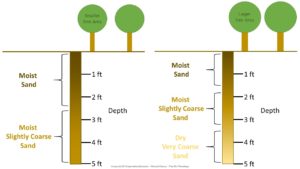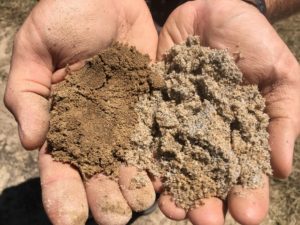The Almond Doctor Field Note is a new series of posts that will cover observations made from the field by staff research assistants of the University of California Cooperative Extension office of Merced County. While Field Note posts may reference completed or on-going research, its intent is share notable observations from the field, not to summarize research findings or describe current recommended farming practices.
Many people are aware that soil types play a significant role with tree vigor and productivity, as well as, affect management decisions relating to irrigation, pre-plant fumigation, fertigation practices, etc. However, many people do not consider how slight changes to soil composition and textures may affect trees and other cropping systems. To help illustrate this point, let us look at two problems recently faced by one Merced County grower with an almond orchard on sandy soil.
The grower had a short-term and a long-term problem associated with the orchard. The short-term problem was the tree’s leaves were turning yellow. The long-term problem was variable growth and vigor in different sections of the orchard. Soil type, topography, and management practices were consistent throughout the orchard.
What could have been the cause of the problems?
The type and extent of yellowing was consistent throughout the orchard and within the tree canopy. The pale leaf color and lack of canopy growth within the orchard suggested that the trees were getting too much water. Typically, yellowing leaves only in the inner canopy indicate too little water, while consistent yellowing across the entire canopy indicate too much water (baring effects from diseases and pests). The conclusion of excessive watering was supported by heavily saturate soil samples days after the last irrigation event.

While excessive water explained the yellowing leaves, it did not fully explain why different sections of the orchard were growing at different rates. Scattered individual trees with higher or lower vigor could be explained by leaky irrigation, infection from diseases, or inconsistent fertigation. However, large disproportionate sections of tree vigor were harder to explain because one would assume all things being equal (e.g., soil type, tree variety, topography, fertigation, irrigation rates, etc.) the trees would grow at the same rate. To help diagnose the variable sections of tree vigor, further soil cores were dug to five-foot depths.
The soil core in the smaller and less vigorous tree section showed a slight soil texture change from sand to slightly coarse sand occurred within the first five feet (see left portion of image below). While there was a slight soil texture change, overall soil and water saturation was consistent.
The soil core in the larger and more vigorous tree section showed something different. Still present was a soil texture change from sand to slightly coarse sand, but this occur with the first three feet not the first five feet. Instead, the soil found at the four- to five-foot depths was very coarse and dry sand (see right portion of image above and photo below).

The above observations lead to the conclusion that the very coarse sand “protected” the trees from the excessive irrigation by providing an area within the rootzone for fast water drainage. The vigorous trees still had access to water from the saturated sand and slightly coarse sand, but did not develop issues associated with prolonged over watering (e.g., stunted growth) because of the well-draining very coarse sand.
The most interesting observation was that these differences in soil composition (saturated soil versus saturated soil with well-draining soil) occurred within 100 feet of each other. Surprising what can be found if one digs a little deeper.
Special thanks to Jennifer Makinson and Allen Vizcarra for their suggestions and impute for this post.


Greg Frost
July 11, 2017This is great information. The question remains, what to do about the variances? We are experiencing similar problems in our orchards.
David Doll
July 14, 2017Greg,
First and foremost, differences in soil texture within future orchards should be identified prior to planting and modified if possible (e.g. slip-plowing, ripping, etc). After planting, there isnt much that can be done with the exception of irrigation management. Proper frequency and duration needs to be determined for the limiting areas within the field. Orchards on variable soils often need to be irrigated more frequently for less duration in order to prevent over-irrigation for trees in areas with hardpans, clay lenses, etc. In the case highlighted above, lack of proper irrigation scheduling led to trees within one soil texture receiving too much water.
As always, when developing an orchard, please reach out to your local Farm Advisor. Soil Pits and backhoes are one of the more fun farm visits to conduct.
David
Jimbo
September 5, 2017Why no updates to The Almond Doctor in the last two months?
David Doll
September 9, 2017Jimbo,
Sorry, I have been swamped. Working on an update now.
David